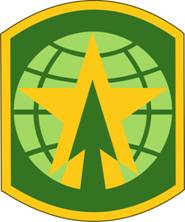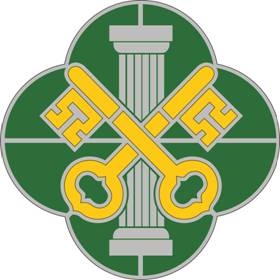Fort Cavazos is a United States Army post located near Killeen, Texas. The post is named after Gen. Richard E. Cavazos, a native Texan and the US Army’s first Hispanic four-star general. Formerly named Fort Hood for Confederate General John Bell Hood, the post is located halfway between Austin and Waco, about 60 mi (97 km) from each, within the U.S. state of Texas. The post is the headquarters of III Armored Corps and First Army Division West and is home to the 1st Cavalry Division and 3rd Cavalry Regiment, among others.

III Corps is a corps of the United States Army headquartered at Fort Cavazos, Texas. It is a major formation of the United States Army Forces Command.

The 16th Military Police Brigade is a military police brigade of the United States Army headquartered at Fort Liberty, North Carolina. This brigade has the only airborne-qualified military police units in the U.S. Army, outside of the 82nd MP Company of the 82nd Airborne Division. It provides law enforcement and police duties to Fort Liberty, and for the XVIII Airborne Corps when deployed. As a brigade with organic airborne units, it is authorized a beret flash and parachute wing trimming, and the shoulder sleeve insignia was authorized to be worn with an airborne tab. According to U.S. Army's Institute of Heraldry, the shoulder sleeve insignia "was amended to delete the airborne tab effective 16 October 2008" when jump status of the brigade was terminated; however, various elements of the brigade remain on jump status.

The United States Army Forces Command (FORSCOM) is the largest United States Army command. It provides expeditionary, regionally engaged, campaign-capable land forces to combatant commanders. Headquartered at Fort Liberty, North Carolina, FORSCOM consists of more than 750,000 active Army, U.S. Army Reserve, and Army National Guard soldiers. FORSCOM was created on 1 July 1973 from the former Continental Army Command (CONARC), who in turn supplanted Army Field Forces and Army Ground Forces.

The 11th Corps Signal Brigade of the United States Army is an element of Army Forces Command. It is based at Fort Cavazos, Texas. The unit mascot is the Thunderbird, a hawk-like bird perched upon a globe shooting thunderbolts out of its eyes. Soldiers in this unit call themselves "The Thunderbirds."

The 13th Armored Corps Sustainment Command—the "Lucky 13th"—is a U.S. Army modular sustainment command which serves as a forward presence for expeditionary operations for a theater, or in support of a regional combatant commander. Corps Sustainment Commands (CSC), such as the 13th, synchronize distribution of supplies and services within their operational areas and provides distribution oversight. Formed at Fort Cavazos, Texas when the 1st Logistics Command deployed to Vietnam, the organization then known as the 13th Support Brigade was initially responsible for the training of technical services units to assume combat service support missions in Southeast Asia.

The reorganization plan of the United States Army was implemented from 2006 to 2016 under the direction of the Brigade Modernization Command. This effort formally began in 2006 when General Peter Schoomaker was given the support to move the Army from its Cold War divisional orientation to a full-spectrum capability with fully manned, equipped and trained brigades; this effort was completed by the end of 2016. It has been the most comprehensive reorganization since World War II and included modular combat brigades, support brigades, and command headquarters, as well as rebalancing the active and reserve components.

The 589th Brigade Support Battalion is a support unit in the 41st Fires Brigade stationed at Grafenwöhr, Germany. The unit was reactivated on 11 January 2019.

The 205th Infantry Brigade, was first formed as part of the United States Army Reserve's 103rd Division. It was active from 1921 to 1942 and then from 1963 through 1994, and then reformed in 2006.

The 411th Engineer Brigade (Theater Army) is a combat engineer brigade of the United States Army headquartered in New Windsor, New York. It is a major engineer command of the United States Army Reserve.

The 89th Military Police Brigade is a military police brigade of the United States Army based at Fort Cavazos, Texas. It is a subordinate unit of III Armored Corps.

The 18th Military Police Brigade is a military police brigade of the United States Army based in Vilseck, Germany, with subordinate battalions and companies stationed throughout Germany. It provides law enforcement and force protection duties to United States Army Europe.

The 728th Military Police Battalion performs Military Police operations to allow for United States forces to move freely through an assigned area. The Battalion also provides law and order to all installations within United States Army Garrison Hawaii. The 728th Military Police has four Companies, and two Detachments, the 39th MP Detachment and the 13th MP Detachment, and a Military Working Dog Detachment 520th MWD Detachment. The 728th Headquarters is located at Schofield Barracks, Hawaii. The Battalion works in support of Headquarters and Headquarters Detachment (HHD) and the Soldiers assigned to it.

The 412th Theater Engineer Command is a United States Army Reserve unit that conducts theater-level engineer operations for Eighth U.S. Army, Korea; U.S. Army Europe; and U.S. Army Pacific, supports continental U.S. – based engineer requirements as directed, and is prepared to participate in Joint and Combined regional contingency operations.

The 420th Engineer Brigade (Corps) is a combat engineer brigade of the United States Army based in Bryan, Texas. It is a United States Army Reserve formation and is subordinate to III Corps.

The 14th Military Police Brigade is a military police unit stationed at Fort Leonard Wood, in Missouri. The 14th Military Police Brigade provides the Army with Soldiers, DA Civilians, and leaders of character who provide the basic and advanced skills required to execute policing, detention, and security mobility support across the range of military operations.
The 793rd Military Police Battalion was a battalion-sized unit in the United States Army stationed at Fort Richardson, Alaska. The battalion was responsible for all Regular Army Military Police units and operations in Germany and eventually in the state of Alaska.

The 97th Military Police Battalion is a Military Police Battalion of the United States Army based at Fort Riley, Kansas. Activated in Europe during World War II, the unit provided military police support and during the Korean War, the 97th Military Police Battalion conducted internment operations throughout the duration of the conflict. Since then, the Battalion has honorably served the country in several conflicts to include Vietnam, Operation Iraqi Freedom, and most recently, returning in July 2010, Operation Enduring Freedom.

The 525th Expeditionary Military Intelligence Brigade (Expeditionary) is a unit of the United States Army specializing in the acquisition and analysis of information with potential military value. On 28 October 2014, the unit was reflagged from the "525th Battlefield Surveillance Brigade" to an expeditionary military intelligence brigade, the first of its kind.

The 93dMilitary Police Battalion of the United States Army was formed in June 1945 and has operated in World War II, the Korean and Vietnam wars, the Gulf War, and the Iraq War.


















